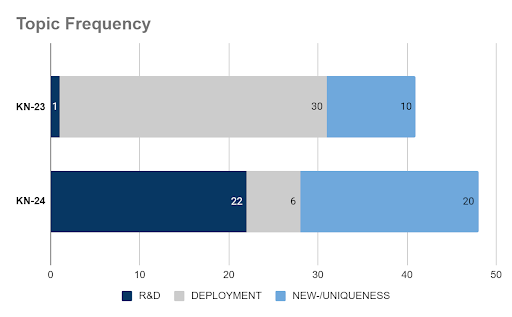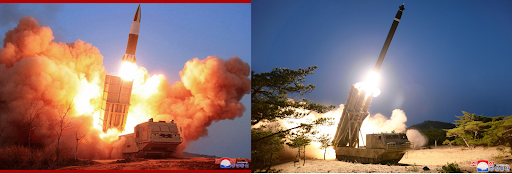
* The article was originally published on ONN's Datayo platform.
Since May 2019, the Democratic People's Republic of Korea (DPRK) [1] has repeatedly tested two new solid-fuel short-range ballistic missiles (SRBM) with largely overlapping performance. Unlike liquid SRBMs, such as the SCUD-B/C [2], the KN-23 and KN-24 [3] missile systems have different designs, means of transportation and launch methods. However, they have some overlapping performance and utility.
In theory, the longer range KN-23, which appeared earlier than KN-24, should have eliminated the need for the latter. The authors examine English and Korean texts about the two system's launch activities from the North’s state-owned Korean Central News Agency (KCNA) in order to understand this parallel development.

Figure 1. Based on Korean-language KCNA articles. Number of text samples: KN-23 (4), KN-24 (3)
KN-23: North Korea's “Tactical Guided Weapon”

Figure 2. In its first two launches four KN-23 missiles were fired along with other long-range artillery projectiles as part of joint strike drills. All KN-23 missiles launched were painted in an army green colour scheme. KN-23 has both tracked and wheeled chassis. The overall appearance of the wheeled chassis shares some similarities to the Iskander missile system's MZKT-7930 truck. Image: KCTV, annotations by authors
As of now, a total of eight KN-23 rounds have been fired in four launch activities carried out between May 2019 to August 2019. The first two KN-23 launches were part of frontline joint drills aiming at testing troop readiness. North Korea's 240 mm, ~300 mm multiple rocket launcher (MRL) systems and its newly developed self-propellant gun system also took part in these drills.
In two Korea Central News Agency (KCNA) articles on 5 May and 10 May 2019, [4] North Korea leader Kim Jong Un's reported focus is "response ability" ["신속반응능력"], "combat readiness" ["전투적성능"] and "combat posture" ["전투동원태세"/"전투동원준비"]. KCNA merely calls the system a "tactical guided weapon" ["전술유도무기"] and does not use the term "new" ["신-"] to describe it.
Only in the third article published on 26 July 2019 [5] does KCNA start to mention that the system is a new one. Including the title, the term "new type tactical guided weapon" ["신형전술유도무기"] appears four times in this article. KCNA also mentions that the system is "to be newly deployed for operation" ["새로 작전배치하게 되는 신형전술유도무기체계"] once, though in the previous two texts, KCNA already indicated that the system has been deployed and mastered by eastern and western front units.
The third KN-23 test is described as a "power demonstration to send a solemn warning to the south Korean military warmongers" [sic] [6] ["남조선군부호전세력들에게 엄중한 경고를 보내기 위한 무력시위의 일환으로"].
Also in the same third article, Kim Jong Un is reported to have said that the demonstration gives him a better understanding of the system's superiority and perfection to the point that he is "gratified by the direct confirmation and conviction of the rapid anti-firepower capability of the tactical guided weapons system and the specific features of the low-altitude gliding and leaping flight orbit of the tactical guided missile" [7] ["전술유도탄의 저고도활공도약형비행궤도의 특성과 그 전투적위력에 대해 직접 확인하고 확신할수 있게 된것을 만족하게 생각한다"]. But the report did not say that he was gratified by the work of those individuals who accomplished the development of the system.
The word "development" ["개발"] directly associated with the KN-23 appeared once in the form of an indirect quote from Kim Jong Un:
"the fact about the development and possession of such state-of-the-art weaponry system is of huge eventful significance in developing our armed forces and guaranteeing the security of the country by military force." [8] ["이러한 첨단무기체계개발보유라는 사실은 우리 무력의 발전과 국가의 군사적안전보장에서 커다란 사변적의의를 가진다고 말씀하시였다." [9]]
"Develop" or "development" ["개발-"] appear another four times in relation to the general munition industry and armed forces in the third article.
In the 7 August 2019 article on the fourth and last KN-23 launch event to date, [10] KCNA describes the officials, scientists and workers as the ones who "successfully conducted the demonstration fire" ["위력시위발사를 성공적으로 단행"], instead of using terms such as who invested in research and development of the system.
In fact, the word "develop" or "development" only appears once in this article. The word "research" also only appears once in this article but it is mentioned in general terms as "direction of researches" ["연구방향"] without explicit reference to KN-23.
Also in the fourth article, the term "new type tactical guided weapon" ["신형전술유도탄"] is mentioned four times if the title is included. The "demonstration fire" ["위력시위발사"] this time is "an occasion to send an adequate warning to the joint military drill now underway by the U.S. and south Korean authorities" ["미국과 남조선당국이 벌려놓은 합동군사연습에 적중한 경고를 보내는 기회가 될것이라"]. It is stated that the demonstration "clearly verified the reliability, security and actual war capacity" ["신뢰성과 안전성,실전능력"] of the system.
KN-24: Emphasis on R&D of the "Juche Projectiles"

Figure 3. The KN-24 SRBM's tracked chassis is similar to that of the KN-25 "super large calibre" MRL (right). Both have driving wheels located in the front but the KN-24 has six road wheels on each side, while the KN-25 has 10 road wheels. All KN-24 missiles launched were painted with a distinguishable testing paint that serves tracking and measurement purposes. Image: KCNA
The KN-24 system has been tested three times with a total of six missiles launched between 10 August 2019 to March 2020. This puts the start of the testing period three days after the last KN-23 fire demonstration on 6 August 2019.
The terms "research and development", "developed" and "development" ["개발-", "연구개발방향"] directly associated with the system appear in the first KN-24 article on August 10 [11]:
"The scientists in the field of national defence science and workers in the field of the munitions industry perfected another new weapon system the orientation of research and development of which was indicated by the Party recently, and made a proud report to the Party Central Committee." ["국방과학자들과 군수로동계급은 당에서 최근에 연구개발방향을 제시한 또 하나의 새 무기체계를 완성하고 당중앙에 자랑찬 보고를 올리였다."]
"He said that the new weapon which was developed to suit the terrain condition of our country and as required by the Juche-oriented war methods has advantageous tactical character different to the existing weapon systems, and explained the strategic and tactical plan of the Party Central Committee which tasked the field of national defence science with the development of the weapon system." ["경애하는 최고령도자동지께서는 우리 나라의 지형조건과 주체전법의 요구에 맞게 개발된 새 무기가 기존의 무기체계들과는 또 다른 우월한 전술적특성을 가진 무기체계라고 하시면서 국방과학부문에 이 무기체계개발과업을 제시한 당중앙의 전략전술적기도에 대하여 설명하시였다."]
In all KN-24 texts, the words "develop" or "development" directly associated with KN-24 appear eight times. The texts make clear that the KN-24 has a research and development phase, and the R&D is conducted in accordance with the Party’s decree. The researchers and developers answer to the Party Central Committee and are able to make "a proud report".
"Juche" ["주체"], or self-reliance, the official state ideology of North Korea, is used on four occasions that are directly associated with KN-24. For example, a typical one is quoted here:
"When he gave the order of fire, powerful Juche projectiles spewed dazzling flashes as if they heralded their birth." [12] ["경애하는 최고령도자동지께서 사격구령을 내리시자 위력한 주체탄들이 자기의 탄생을 알리듯 눈부신 섬광을 내뿜었다."] [13]
Generally, the KN-24 articles a more flowery language with passionate sentiment absent in the KN-23 reports, as, for example, evidenced by the "dazzling flashes" that "heralded the birth" of the "Juche projectiles" in the sentence above. The word "birth" [탄생], which, in this context, could be interpreted as the devoted labour to a national creation, appeared three times in two of the English KN-24 articles and twice in the Korean version. [14] The term "Juche" is used another four times in more general terms in all KN-24 articles, such as:
"Our party has strictly maintained the principles of self-reliance and Juche in national defence building, and recently set forth a strategic policy on the direction of the development of the Juche-oriented national defence building based on our own science, technology and strength to meet the needs of the developing situation ... ." [15] ["우리 당은 국방건설에서 철두철미 자력과 주체를 견지해왔으며 최근시기 현실발전의 요구에 맞게 우리의 과학과 기술,우리의 힘에 토대한 주체적국방건설발전방향에 관한 전략적방침을 제시했다 ... " [16]]
Overall, "Juche" appears eight times in KN-24 articles, but does not appear once in the four articles containing KN-23. One can also easily find clear indications of a gradual developmental process in the KN-24 articles. Such as:
"The detailed analysis of the test-fire result proved that the design of the advantageous and powerful new weapon system was perfectly materialized." [17] ["시험사격결과에 대한 세밀한 분석을 통하여 새 무기체계의 우월하고도 위력한 설계상요구가 완벽하게 현실화되였다는것이 확증되였다." [18]]
"The national defense scientists showed a perfect result in the test-fire, too, and helped cement bigger confidence in this weapon system." [19] ["국방과학자들은 이번 시험사격에서도 완벽한 결과를 보여주었으며 이 무기체계에 대한 보다 큰 확신을 굳힐수 있게 해주었다." [20]]
"The fire clearly proved the characters of different flight trajectories and falling angles, accuracy of guided shells and their power … reconfirming and showing to the KPA commanding officers the tactical characters and power of a new weapon system to be delivered to KPA units ... ." [21] ["시범사격에서 서로 다르게 설정된 비행궤도의 특성과 락각특성,유도탄의 명중성과 탄두위력이 뚜렷이 과시되였다." [22]]
The excerpts above imply that the KN-24 is, by design, a newly and domestically developed weapon that is tested to improve performance and is yet to be delivered to the armed forces. In comparison, the focus on operating ability, combat readiness and posture in the first two KN-23 articles suggest that the KN-23 system has been operated by North Korean troops for some time. The other two KN-23 articles describe the firings as power demonstrations that served as warnings to South Korea and the US. Overall, the texts give the impression that KN-23 is not an indigenous project.
An examination on KCNA texts about KN-25, North Korea's "super large calibre" rocket launcher, also shows clearly that the KN-25 is an indigenous system with a clear, dragual developmental process. The KN-24 texts, along with the KN-25 KCNA texts, make a stark contrast to the KN-23 texts (Table 1). The latter reporting carries a much less passionate sentiment and implies a weapon that already exists and has been deployed at the frontline.
| Topic | Keyword | KN-23 | KN-24 | KN-25 |
|---|---|---|---|---|
| R&D |
Develop/Development [개발] |
1 [1] | 8 [8] | 9 [9] |
|
Research/Research and Development [연구/ 연구개발] |
0 [0] | 1 [1] | 0 [2] | |
|
Birth |
0 [0] | 3 [2] | 0 [0] | |
|
Conceive |
0 [0] | 0 [0] | 1 [1] | |
|
Test/Test fire |
0 [0] | 10 [10] | 41 [43] | |
| Deployment |
Deploy/Deployment (~in active duty) |
3 [3] | 0 [0] | 1 [1] |
|
Drill/Strike drill |
14 [14] | 0 [0] | 11 [16] | |
|
Demonstration/Power demonstration/Demonstration fire/Demonstrate |
13 [13] | 2 [6] | 0 [0] | |
| New-/Uniqueness |
New |
9 [10] | 14 [14] | 9 [9] |
|
Juche |
0 [0] | 4 [4] | 2 [2] | |
|
Style/Korean-style/our style |
0 [0] | 2 [2] | 3 [3] |
Table 1. Frequency of Keywords in KN-23/24/25 articles to date.
Note 1: Only words in direct relation to KN-23/24/25 are counted.
Note 2: In the articles on the KN-23, "demonstration" is used in the context of warnings to the US and South Korea. In contrast, in the articles on the KN-24, the term is used in the context of demonstrating performance to the Korean People's Army officers fully before delivery.
Conclusion
Text analysis alone cannot offer a definitive answer as to why North Korea now has two similar, overlapping systems. However, it may offer a perspective and a working hypothesis:
KCNA texts imply that the KN-23 is not a "Juche weapon of Korean style", it was used first in joint artillery drills and then as a tool for power demonstration against adversaries, which means the KN-23 might have been in limited deployment before being tested. One possible explanation is that the KN-23 might be a weapon utilizing foreign subsystems, such as guidance set, motor section and/or the upper airframe. Or, it might be imported as a whole with some of its small details locally modified to conceal its origin, such as with the extended cable raceway and the slightly modified shape of wings. There might be a precedent for deployment without testing in North Korea. The Hwasong-10/Musudan missile was assessed by some experts as having been deployed this way. [23]
On the other hand, as KCNA texts put it, the KN-24 is a "Juche weapon of Korean style" built to suit the North Korean terrain conditions. Though its maximum range is about 200 km shy of that of KN-23, it seems that it could still meet the demands of North Korea: both KN-24 and KN-25 exhibited a maximum range of about 400 km.
To sum up, the findings from the text analysis supports a hypothesis that the KN-23 is not an indigenous project, while the KN-24 is a domestic effort to have similar ability by incorporating some of KN-23's key elements.
[1] Hereinafter referred to as North Korea.
[2] SCUD-C is SCUD-B's extended range version through reduced throw weight and a small increase in propellant volume.
[3] Datayo will use their US government designations before official designations are confirmed.
[4] 김정은동지께서 전연 및 동부전선방어부대들의 화력타격훈련을 지도 [Supreme Leader Kim Jong Un Guides Strike Drill of Defence Units in Frontline Area and on Eastern Front], KCNA, 5 May 2019; 김정은동지께서 조선인민군 전연 및 서부전선방어부대들의 화력타격훈련을 지도 [Supreme Leader Kim Jong Un Guides Strike Drill of Defence Units in Forefront Area and on Western Front], KCNA, 10 May 2019
[5] Supreme Leader Kim Jong Un Guides Power Demonstration Fire of New-Type Tactical Guided Weapon, KCNA, 26 July 2019
[6] KCNA does not capitalise "South" when referring to South Korea.
[7] The quote (including Korean version) is from the official KCNA English text.
[8] Supreme Leader Kim Jong Un Guides Power Demonstration Fire of New-Type Tactical Guided Weapon, KCNA, 26 July 2019
[9] 김정은동지께서 신형전술유도무기 위력시위사격 조직지도, KCNA, 26 July 2019
[10] Supreme Leader Kim Jong Un Watches Demonstration Fire of New-Type Tactical Guided Missiles, KCNA, 7 August 2019
[11] 김정은동지께서 새 무기 시험사격을 지도 [Supreme Leader Kim Jong Un Guides Test-Fire of New Weapon], KCNA, 11 August 2019
[12] Supreme Leader Kim Jong Un Guides Test-Fire of New Weapon, KCNA, 11 August 2019
[13] 김정은동지께서 새 무기 시험사격을 지도, KCNA, 11 August 2019
[14] In the 22 March 2019 article it appears to have been translated from "출현" [emergence, appearance].
[15] Supreme Leader Kim Jong Un Guides Test-fire of New Weapon Again, KCNA, 17 August 2019
[16] 김정은동지께서 새 무기 시험사격을 또다시 지도, KCNA, 17 August 2019
[17] Supreme Leader Kim Jong Un Watches Demonstration Fire of New-Type Tactical Guided Missiles, KCNA, 17 August 2019
[18] 김정은동지께서 새 무기 시험사격을 지도, KCNA, 11 August 2019
[19] Supreme Leader Kim Jong Un Guides Test-fire of New Weapon Again, KCNA, 17 August 2019
[20] 김정은동지께서 새 무기 시험사격을 또다시 지도, KCNA, 17 August 2019
[21] Supreme Leader Kim Jong Un Observes Demonstration Fire of Tactical Guided Weapon, KCNA, 22 March 2020
[22] 경애하는 최고령도자 김정은동지께서 전술유도무기 시범사격을 보시였다, KCNA, 22 March 2020
[23] North Korea Missile Capabilities, Nuclear Threat Initiative, 1 May 2010, available at: https://www.nti.org/analysis/articles/north-korea-missile-capabilities/